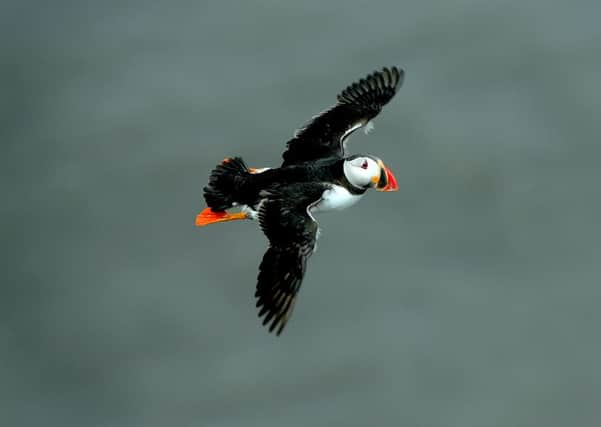Picture Post: Clowns of the sea that face uncertain future


Their striking appearance has made them popular among generations of bird watchers and this wonderful photograph taken near Bempton Cliffs nature reserve, which is run by the RSPB, captures one in full flight.
This reserve, near Bridlington on Yorkshire’s coast, must be one of the best places in the country to come and see, hear and smell seabirds, with more than 250,000 of them flocking to the cliffs between Bempton and Flamborough each year to find a mate and raise their young.
Advertisement
Hide AdAdvertisement
Hide AdThe cliffs are best known for the breeding seabirds, including orthern Gannet, Atlantic Puffin, Razorbill, common Guillemot, Black-legged Kittiwake and Fulmar.
One of the favourites sights are the Atlantic, or Common, Puffins. These little birds only grow to 30cm and generally arrive on the cliffs from mid-April to the end of July, nesting in rock crevices to protect them from the worst of the elements.
It’s thought that over 6,000 puffins visit Bempton, and visitors can admire them in full flight as they return from their feeding grounds at Dogger Bank with sand eels dangling from their beaks.
But beautiful as these puffins are they face an uncertain future. A long-term study of a large colony on Shetland suggests that numbers breeding there have halved from about 20,000 to 10,000.
Advertisement
Hide AdAdvertisement
Hide AdThe study, published in a scientific journal this week, covers a period of almost 30 years.
Experts are unsure of the exact reason for the drop in numbers but believe it may be due to declining local fish stocks and poor feeding conditions for seabirds off Shetland.
The report comes as puffins have been classified as at risk of extinction across Europe because of climate change and a lack of food.
We can only hope that this decline is reversed so that sights like this don’t become a thing of the past.
Technical details: Nikon D3’s, Lens Nikon VR 300mm, Shutter Speed 1/1250s, Aperture f/6.3, ISO 500.
Picture: James Hardisty
Words: Chris Bond